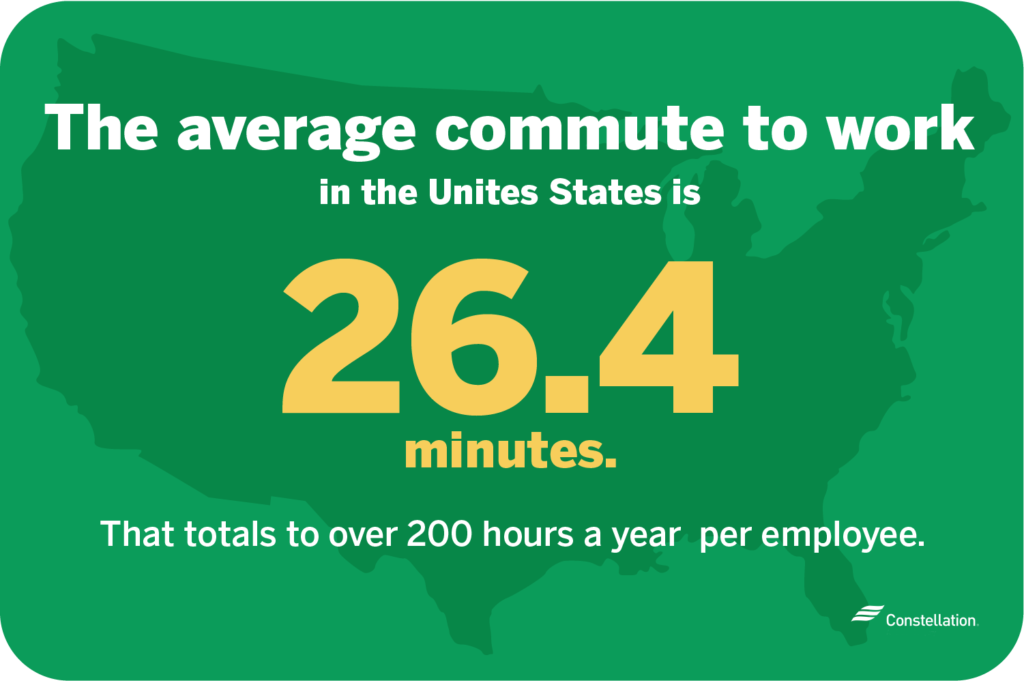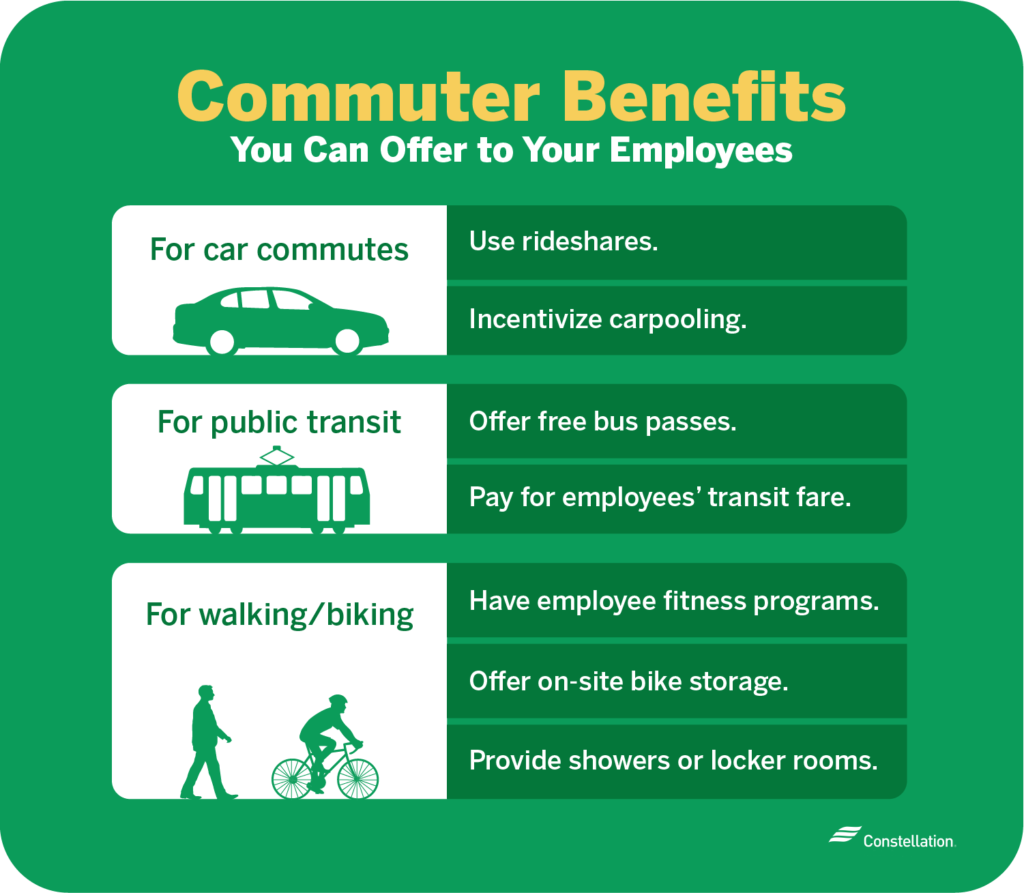
- Category:
Small Business Energy Savings -
Last updated:
April 16, 2025
How Employee Commuter Benefits Attract and Retain Talent
Approximately 150 million Americans commute to work every day, according to the United States Census Bureau, with the vast majority (128 million) using personal automobiles. The amount of energy used to accomplish a daily commute is staggering; the average person spends $2,600 a year going to and from work.
The environmental cost is equally vast, as personal transportation accounts for 20% of the nation’s greenhouse gas emissions. Small-business owners can help employees find the best way to commute to work while saving energy, increasing employee retention and even earning tax breaks by participating in transit benefit programs.
What is the average commute to work for employees?

The average commute to work is 26.4 minutes, with many employees spending more time on the road. Presuming a full-time, five-day workweek and round-trip commutes, commuting to work eats up over 200 hours a year per employee — or approximately nine days’ worth of travel time.
An average commute to work in busy traffic can leave employees frustrated and tired before they even clock in, reducing their productivity. Commutes home also affect productivity, as employees start thinking — and worrying — about the journey home in the last hours of their shift. Employees with exceptionally long or stressful commutes may even choose to leave the company in favor of working closer to home.
Unlocking success with commuter benefits programs
Commuter benefits programs, also known as transit benefit programs or qualified transportation fringes, help small businesses provide their employees with commuting solutions, reducing employee stress and energy consumption.
What are these commuter benefits programs?
Commuter benefits programs are voluntary employee programs that offer commuter benefits for employees. Programs may be overseen by the employer or a third party, or they may be part of a state-run program.
How do commuter benefits programs work?
Commuter benefits programs work by helping employees use less energy during their commute by supporting carpooling, offering subsidies for work-related parking costs and promoting ways to commute without a car, such as bicycling or using public transit.
How can commuter benefits help you attract employees?
Commuter benefits help you attract employees because they are fringe benefits — small but meaningful perks that come with working for the company. In a competitive labor market, fringe benefits help sell your company as a desirable place to work. Employees who enjoy fringe benefits are also more likely to remain with the company.
How can commuter benefits programs help you save?
Commuter benefits programs help employees save energy during their commutes, which is great from an environmental stance. From a financial standpoint, transit benefit programs also offer value to employers. Commuter expenses are exempt from federal income and payroll taxes and are often excluded from state taxes as well.
How do you know whether transit benefit programs are offered near you?
Most states offer transit benefits. Check your state’s website to see what benefits they offer and how to access them.
Employee commuter benefit ideas
Employers can help employees explore alternative ways to commute to cut down on energy use. Rideshares, public transit and other ways to commute without a car are all options.

Commuting to work by car
Cars are by far the most popular means of commuting, but they are also the costliest in terms of energy consumption and carbon emissions. The average car emits 4.6 metric tons of carbon dioxide per year.
What you can do for your employees:
- Encourage your employees to use rideshares. Rideshares are an increasingly popular way to conserve energy during a commute. Several employees can use the same rideshare, saving on energy while also reducing work-related parking costs. Uber and Lyft are two of the largest ride-sharing companies in the country.
- Incentivize employees to carpool with coworkers. Carpooling has long been used to reduce commuting energy while sharing the costs of the commute. The group shares the expense of gas and parking, and when not driving, employees can relax, browse mobile apps or even catch up on work emails.
What your employees can do to save energy:
- Drive fuel-efficient vehicles. Older cars are not as fuel-efficient as newer models. Hybrids and electric cars offer even greater benefit and significantly reduce carbon emissions.
- Make sure their tires are properly inflated. Underinflated tires increase fuel consumption by as much as 0.2% for every 1 psi drop in tire pressure. Keeping tires properly inflated can improve fuel efficiency by as much as 3%.
Pro tip! Employees can save on commuting expenses by keeping an eye out for gas stations with lower fuel prices and filling up when they find them. People who wait until their tank is empty have no choice but to gas up at the nearest station, regardless of price. You can even find apps that help you locate the cheapest gas along your commute.
Commuting to work by public transit
Public transit offers ways for employees to commute without a car. Using public buses or trains reduces carbon dioxide emissions by 4,627 pounds per person while saving on gas and parking costs.
What you can do for your employees:
- Provide free bus tickets or passes. Ask your local bus service whether your employees can take advantage of free passes for commuting.
- Assist employees in paying for their transit fare. You can offer to reimburse or subsidize public transit tickets as part of your employee commuter benefits program.
What your employees can do to save energy:
- Take public transportation if it’s available. Employees who live directly on bus or train lines have a commuting advantage over their coworkers who don’t. Remind such employees that they have ways to commute without a car.
- Look into weekly or monthly passes, or travel during off-peak times. Purchasing weekly or monthly public transit passes is usually more cost-effective than paying for each trip separately. Employees who can commute during off-peak hours will also save money.
Active ways to commute to work
Employees who live close to work can turn their commute into a healthy walk or bicycle ride. Both cycling and walking burn calories while eliminating the carbon emissions produced when commuting in automobiles. As an employer, you can encourage healthy, active commuting.
What you can do for your employees:
- Create an employee fitness program. Making healthy living part of your corporate culture gets employees excited about fitness and encourages them to take part in active commuting.
- Provide a place for employees to store bikes or other gear. Bicycles are common targets for thieves, and concerns about the safety of their bikes can prevent employees from using them to commute. Provide a safe location where employees can securely store bicycles, helmets and other equipment.
- Offer a place for employees to shower and/or change clothes. Walking or bicycling to work requires physical exertion, which naturally leads to sweat. Providing a place to shower or change clothes can mean the difference between an active commute and a car ride.
What your employees can do to save energy:
- Walk. Walking is the best way to reduce a commuter’s carbon footprint. Not only is walking healthy, but it also offers a chance for employees to mentally prepare for the workday. Not everyone is at the same fitness level, of course, so the distance someone is capable of walking varies from person to person.
- Bike. Cycling is great aerobic exercise and helps employees avoid traffic congestion. Employees who bicycle to work should be aware of the dangers associated with distracted drivers, who can make cycling riskier than walking.
- Take a scooter. Scooters are a relatively new method of commuting, and some companies offer electric scooter rentals for a minimal fee. As with walking and cycling, employees must take commuting distance into account when using scooters.
Additional energy-saving ideas for employees:
- Work remotely. The absolute best way for employees to commute to work is not to commute at all. Employees who telecommute or work remotely don’t have to expend any energy getting to work, and you’ll save on office energy too. In addition, remote work often results in an increase in productivity, as employees aren’t tired from their commute don’t want to lose the privilege of working from home.
- Use smart-device routines. Preparing for the workday is often a rushed affair, and many employees struggle to find enough time to eat breakfast or help kids get ready for school after waking up, showering and getting dressed. Smart-home routines take some of the pressure off an employee’s morning by making certain tasks automatic. They also help save energy by automatically turning off lights, coffee machines and other appliances.
Commuting is part of your employees’ work experience, and when you help them save energy on their commute, you’re also helping improve their workday — and their quality of life.




